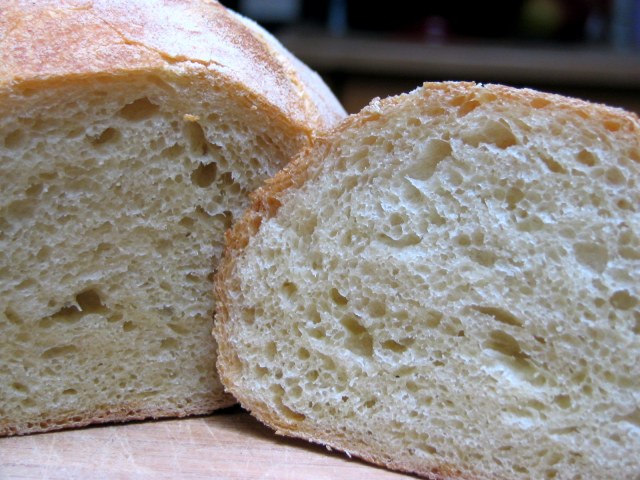Those who follow my blog might be aware that I am a huge fan of Helen Fletcher. When she praises a recipe, I just know it will be awesome. Still, this one surpassed all my expectations. Gibassier is a little brioche-like delicacy from Provence, a place that enchanted me when I visited many years ago, right during lavender harvesting season. I will never forget the fields and the intense but delicate lavender aroma present everywhere. Helen’s recipe is a breeze to make using the food processor, but she also gives detailed instructions to make it in a regular mixer.
GIBASSIER
(from Pastries Like a Pro)
Preferment (Biga):
140 g bread flour
1/2 cup warm milk (about 105°F)
Large pinch of instant yeast
Stir together in a small bowl. Knead several times to make a smooth ball. Let sit at room temperature for 12 to 18 hours.
Gibassier Dough:
385 grams bread flour
6 tablespoons unsalted butter, cold (85 grams)
100 grams granulated sugar or 3 1/2 ounces)
2 + 1/2 teaspoons instant yeast
3/4 teaspoon salt
Orange zest from l medium navel orange
All of preferment from above
2 eggs
1/3 cup olive oil
1/4 cup water, divided
1/4 tsp Fiori di Sicilia (optional)
2/3 cup candied orange rind
Place the flour in the processor and pulse several times. Cut the cold butter into pieces and arrange in a circle over the flour. Process until the butter is no longer distinguishable.
Add the sugar, yeast, salt, zest, and Fiori di Sicilia. Pulse to incorporate. Tear the preferment into pieces and add it processor. Process to fully incorporate.
Combine the eggs, olive oil, and half of the water. Pour over the dry ingredients and process to mix completely. Scrape down and rearrange the dough if necessary. The dough should be very soft. Add water a teaspoon at a time if necessary (I did not use additional water). Add the candied orange rind. Pulse briefly to mix. Do not over mix or the rind will be too small.
Let the dough proof at room temperature for 2 hours, then deflate the dough and transfer to the fridge overnight
Shape the Gibassier. Line two half-sheet pans with parchment paper. Turn the dough out. Weigh your dough and do the math to find out how many grams you should use to form each little dough. You should have enough for 14 gibassiers. In my case, I used 80 grams per little ball. Shape all the balls, cover, and refrigerate to make it easier to cut them. Take two or three out at a time so they don’t soften too much. Take a ball and stretch it out with your fingers to make a rough torpedo shape. Turn it so the best side is up. With the heel of your hand press the top of the dough upward from the middle. Again from the middle of the dough, with the heel of your hand press the dough downward to form a lemon shape. Flatten the ends to match the center. It shoud be abut 2 1/2 ” high.
With a single edge razor blade, make a cut in the middle of the dough.Then one to the left. One to the right. Along the right side of the top of the dough cut in toward the center about 3/4” to 1”. Again on the other side. Last cut in the same amount on the right side. And on the left. As you pick it up to put it on the sheet pan, stretch it out to enlarge the holes. Place 7 on a tray.
Cover them and allow them to rise for 2 to 2 1/2 hours until puffy.
Heat the oven to 350F. While the oven is heating brush 2 or 3 of the rolls with the egg wash and sprinkle heavily with sanding sugar or pearl sugar. Bake one sheet at a time on the middle rung for 18 to 22 minutes until golden brown and baked through.
Serve warm or room temperature.
ENJOY!
to print the recipe, click here
Comments: If you’d like to make Gibassier, I urge you to stop by Helen’s site because her step-by-step photos are perfect to understand what needs to be done. Explaining just with words is a bit tricky. If you make it in the food processor, it will be easy to make just half the recipe, as the processor will handle it without issues. Everything comes together super quickly, and I like the fact that I could use butter straight from the fridge.
Some people suggest using an old credit card to do the cuts on the dough, but Helen’s idea of getting those single edged razor blades is truly spot on. I advise you to allow the final proofing to reach the 2.5 hour mark or even a little big longer as enriched doughs tend to be a bit sluggish. The puffier they get at that stage, the lighter the rolls will be. I had to cut my final proofing a bit short for half of them, and the second batch was better.

This is the type of pastry that will transport you straight to a cafe in France, sitting outside, people-watching, as you sip a little hot chocolate, coffee, or whatever suits your mood…
Helen, thank you once again not only for the inspiration but for your detailed instructions that make it all so much easier to follow.
ONE YEAR AGO: Sundried Tomato Twist Bread
TWO YEAR AGO: And now for something completely different….
THREE YEARS AGO: Parsnip, Coconut, and Lemongrass Soup
FOUR YEARS AGO: In My Kitchen, October 2016
FIVE YEARS AGO: Paleo Moussaka
SIX YEARS AGO: In My Kitchen, October 2014
SEVEN YEARS AGO: In My Kitchen, October 2013
EIGHT YEARS AGO: Crimson and Cream Turkey Chili
NINE YEARS AGO: Taking a break from the nano-kitchen
TEN YEARS AGO: Chocolate Chip Cookies




























